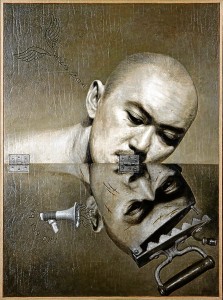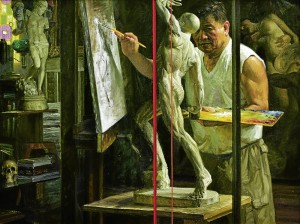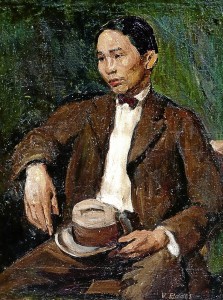
A stunning selection of a hundred self-portraits by Filipino artists, titled “Imagining Identity,” will be on view this month.
It is the third in a series of systematically curated shows through which Paulino Que has shared his private collection with the public.
Previous exhibitions, also designed by Nilo Ilarde, were “Figuring the Times” (2009) and “Meaning to be Modern” (2010). All three have been documented in limited-edition catalogues by art historian and critic Patrick Flores.
Que began collecting in the late 1970s. Today, the unassuming Paulino, who is in his mid-50s, is often seen with his pretty wife Hetty among Manila’s cognoscenti during art events. Their extensive collection, built through dedication and connoisseurship, now provides the standard not only of good taste but also of investment-grade art and antiques.
“Imagining Identity” showcases nearly two centuries of works in a variety of visual media on the most difficult of artists’ subjects: himself.
Self-portraiture usually requires a reflective surface or mirror (or, these days, a photograph or digital image), which enables the artist to render a representation of his physical presence. More important, the work represents an analytical perception of his state of being, real or idealized, expressed in an artistic manner.


Self-portraits explore the relationship of the artist with himself, between the artist’s inner world and the outside world, between his past, present and future.
Annie Cabigting’s (born 1971) is among the most interesting statements on identity and the function of art. The work is based on a photograph taken of her by gallerist Vita Sarenas in Singapore. The artist, her back turned to the viewer, is looking at her own painting, itself an appropriation from a magazine cover.
Cabigting emphasizes that the object of art is not its material presence, but the act of apprehension. Self-portraiture is not only a representation of one’s looks, but the artist’s act of looking, his or her ability to see.
Mirror image
Wire Tuazon’s (born 1973) “Introspections of the Image Duplicator” shows the artist looking at himself in the mirror, superimposed with the text “Another Artist”: the first word is over the mirror image, and the other is over himself. The text may seem self-deprecating, but the work is a succinct treatise on dissociation, which is the first step toward imagining identity. The artist must recognize the “Other” in order to define the “I”.
Mark Justiniani’s (born 1966) “Kami” is a depiction of the artist’s multiplicity of personality and reality: He is dwarfed by his own overbearing shadow as well as his larger-than-life “Other,” turned around and head-over-heels in the mad quest for art. The state of dissociation is also seen in Alfredo Esquillo’s (born 1972) “Flip Side,” and Leslie de Chavez’s (born 1978) “Through the Looking Glass.”
A gem in the Que collection is the earliest known self-portrait in Philippine art, by Damian Domingo (1796-1833), who established the first art school in the country in 1821. Domingo painted himself to look more Español than mestizo. The miniature oil-on-ivory sheet—painted in 1826—was thought to have been lost, but later surfaced in the Luis Araneta collection. Because the work symbolizes a beginning, it is now in a jeweled monture of 22-karat gold, encased in sterling silver, mother-of-pearl and the egg of a locally bred ostrich.
The first self-portrait acquired by Paulino Que, in the early 1980s, was “Indio Bravo,” a quick oil sketch painted on panel by Juan Luna (1857-1899) in 1886. Luna’s self-portrait is an appropriation from a photograph taken by camera buff Felix Resurreccion Hidalgo in Paris. The original series of photos shows Luna fencing with Rizal, with Luna’s wife Paz and their son Andres sitting relaxed on the steps of their apartment building.
Strongest works
Over the subsequent decades, Paulino acquired other artists’ self-portraits as they came into the market, particularly those of Masters such as Fabian de la Rosa (1869-1937), Fernando Amorsolo (1892-1972), Romeo Tabuena (born 1932), José Joya (1931-1995), Federico Aguilar Alcuaz (1932-2011), among others.
One of the strongest works is that of Victorio Edades (1895-1995). It was exhibited in the National Artist’s landmark exhibition in 1928, which introduced modernism in the country. It shows a very Filipino man, dressed in a Western suit and hat; still young, but strong of will, as suggested by his disproportionately large hands and by the slashes of hues.
The sober formality of Edades contrasts with Danilo Dalena’s (born 1943) insouciant air: The latter is in a rumpled jumpsuit, seated in a batibot, with feet tucked under him, his wooden clogs askew on the rough floor.
Onib Olmedo (1937-1996) sits naked before us, his scowl heightened by the overlapping of planes of shadow and light. Over his crotch rests his hand, wielding a wide-tipped brush.
Fernando Zobel (1924-1984) painted a painting within a painting. On the upper right side is an impression of a self-portrait that hung in Zobel’s studio: an airy room with low bookshelves, swivel chair and huge window looking out into a wall covered in climbing vine.
Whereas Zobel saw the underlying color and pattern in the world around him, Romulo Galicano (born 1945) is more conscious of the baroque surfaces he has chosen to surround himself with.
Realizing that few artists actually attempted self-portraits, over the past decade Paulino eventually began commissioning them.
The National Artist Arturo Luz (born 1926) consented to paint for Que a rare self-portrait. Contrasting with Galicano’s extravagant imagery is Luz’s spare elegance. Luz only outlined his rather distinctive head. Over his face is a mask-like field of black with slits for the eyes, referring to the self-imposed discipline of art, which limits the way he looks at the world, but also is the way he chooses that the world see him.
Manuel Ocampo (born 1965) is radical, with Outsider Art’s deconstructive images in his “Self-Portrait as a Little Fairy.” The old man is an allusion to St. Jerome, who translated the Bible into Latin, representing orthodoxy. Usually depicted unshod, with a fierce lion, symbolizing Jerome’s taming of the wilderness, Ocampo shows a hermit instead wearing shoes, beside a domesticated cat, symbolizing religion’s incongruity. But the artist slyly argues: Isn’t art also tyrannical, and the herald of empty promises?
Some artists depicted themselves at various stages of their lives. José John Santos III (born 1970) shows himself as a child, merely absorbed in eating from the bowl before him. National Artists Ang Kiukok (1931-2005), and Benedicto “Bencab” Cabrera (born 1942), show themselves late in life.
Many artists chose not only to show their physical appearance, but their inner selves. Some self-portraits are disturbing: At the center of Romeo Lee’s (born 1956) “Twitty in the Big City” is a fascistic figure, aswang and other monsters abusing the fledgling. Jojo Legaspi’s (born 1959) is a visual treatise on the role of religion in suppressing desire and the Unconscious. Robert Langenegger’s (born 1983) depicts the artist as a social victim, fit to be thrown away like garbage.
This most comprehensive exhibition of Filipino self-portraits ever is an absorbing display not only of the skill and talents of our best and brightest, but a journey into the lives and psyches of very interesting men and women—artists all—of the past, and of these our complex times.
“Imagining Identity” is on view Feb. 9-March 3 at Finale Art File’s Warehouse 17 at La Fuerza Compound, Pasong Tamo, Makati City. For information, e-mail finale@pldtdsl.net

